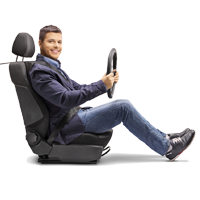According to Nielsen, 2,804,826 adults tune in to their favorite Detroit radio stations every week. This is significantly more consumers than are reached by all other advertising-supported media, including local TV, local cable, streaming video, social media, online audio, and local newspapers.
Detroit radio's unchallenged reach is why many local business owners depend on the medium to capture the largest possible share of the $88.4 billion dollars consumers are expected to spend at retail this year.
Other local small business owners, however, may be surprised to learn that by most marketing metrics, radio remains the best way to advertise in Detroit.
Here are four more facts about AM/FM radio that may surprise many local marketers.
Read More
Topics
television,
television advertising,
radio advertising,
best way to advertise,
streaming audio,
cable TV,
in-car audio,
CTV,
local television,
how to advertise,
am/fm radio
Detroit radio reaches more local consumers each week than any other advertising medium.
According to Nielsen, 2,804,826 adults tune in to their favorite AM/FM stations every week. This is significantly more consumers than are reached by Detroit TV, cable, streaming video, streaming audio, social media, or newspapers.
AM/FM radio's dominance among local consumers is driven, in large part, by the 3.2 million Detroit area adults who take to the road in their car or truck every week, according to Neilsen.
Read More
Topics
radio advertising,
best way to advertise,
reach,
reach and frequency,
streaming audio,
advertising reach,
in-car audio,
share of ear,
car radio,
streaming media,
am/fm radio
Every week, according to new Nielsen data, 2,778,339 adults tune in to a Detroit radio station. This is more consumers than use social media, access local cable, watch broadcast TV, stream video channels, listen to streaming audio, read a newspaper, or download a podcast.
Based on per capita estimates from the National Retail Federation (NRF), Detroit consumers are expected to spend between $67.6 and $68.9 billion at retail in 2022, a six to eight percent growth over the previous year. Utilizing radio's enormous advertising reach, local business owners can compel shoppers to spend this large pool of cash in their stores and on their websites.
The number of consumers reached is critical to the success of an advertising campaign.
According to a Nielsen study, after the actual content of the commercial message itself, reach is the most potent advertising element that can drive sales. Reach is more important than brand, recency, or even context. Detroit radio provides local business owners with the most significant reach among consumers.
Read More
Topics
small business,
small business owner,
best way to advertise,
reach,
reach and frequency,
retail,
return on investment,
ROI,
retailer,
retail sales,
retail store,
advertising reach,
in-car audio,
small business marketing,
small business advertising,
retail spending,
advertising return on investment,
advertising roi
There are about 2,900,000 registered passenger vehicles in the Detroit area. Some are cars. Some are trucks. Some are Hondas. Some are Fords. Some are Teslas. Some have four doors. Some have two. Some go fast. Some go slow. Some guzzle gas. Some sip. Some are red. Some are blue.
The one thing that almost every car and truck in the Detroit area have in common, though, is the AM/FM radio smack-dab in the middle of the dashboard.
The first car radio went on sale in 1930. It was an invention of the Galvin Manufacturing Company. The company named the radio 'Motorola,' and its cost was $130, around $2000 in today's dollars. By 1935, more than three million car radios had been installed.
Today, AM/FM radio is part of every car and truck on Detroit area roads. In addition to the radio, many of these vehicles also provide drivers with other audio options, including a CD player, Sirius/XM, Pandora, Spotify, podcasts, and easy access to personal MP3 collections.
It is fair, then, for small business owners who depend on Detroit radio to advertise their goods and services to ask: with all the audio options on today's dashboards, is anyone listening to local AM/FM radio in the car anymore?
Read More
Topics
radio advertising,
best way to advertise,
pandora,
spotify,
automotive,
streaming audio,
in-car audio,
podcasts,
sirius/xm,
share of ear,
podcasting,
car radio,
streaming media
In 2020, there were 251,685 new cars and trucks registered in the Detroit metro area. This number is based on projections from the National Auto Dealers Associaton (NADA) and the U.S. Census bureau.
In all, says NADA, there are 614 new-car dealerships in Michigan. Despite the pandemic, these dealers, including those in the Detroit area, sold $38.2 billion worth of new vehicles.
Through June of this year, these same dealers have already rung up $20.5 billion in new car sales.
When it comes to buying new vehicles, Detroit consumers have a broad range of preferences. Some buyers want Fords while others want Chevrolets, Toyotas, or Teslas. Some buyers want pick-up trucks, while others want sub-compacts, SUVs, or sports cars. Of course, some want blue vehicles, while others want pearl white, orchard green, or redolent red.
There is one purchase criterion, however, that most Detroit car buyers can agree on. They want an AM/FM radio smack-dab, in the middle of their dash.
Read More
Topics
automotive,
in-car audio,
vehicle traffic,
detroit radio,
advertise on detroit radio,
used trucks,
used vehicles,
used cars,
advertise in Detroit,
new cars,
car radio,
who listens to Detroit Radio
In 1920, when WWJ became the first radio station in Southeast Michigan, many considered the medium a fad. Even in 1937, a hit song by George Gershwin, Our Love Is Here To Stay, considered radio to be a "passing fancy and in time may go".
Detroit radio, however, has survived the advent of talking-movies, television, eight tracks, and cassettes in stereo. More recently, radio has withstood a tsunami of digital options including, YouTube, SiriusXM, Pandora, and Spotify.
As the Coronavirus pandemic rolls over into a second year, Detroit radio has hung tough and not ceded its ground despite listener's shifting lifestyles. This is crucial news for local small business owners who depend on local stations to market their goods and services.
Read More
Topics
best way to advertise,
reach,
return on investment,
ROI,
corona,
coronavirus,
covid 19,
recession,
advertising reach,
in-car audio,
pandemic,
time spent listening,
work from home,
radio listening,
listening location,
commuting
Since 1920, advertising on Detroit radio has helped small business owners survive and thrive during times of peril. This includes world wars, natural disasters, depressions, and recessions.
Even during a pandemic, by almost every key marketing metric, radio advertising remains the best way for a Detroit business to market its goods and services.
To prove the point, here are five statistics that vividly demonstrate the value of advertising on Detroit radio.
Read More
Topics
reach,
retail,
return on investment,
ROI,
retailer,
retail sales,
retail store,
web traffic,
website visitor,
in-car audio,
radio commercials,
listening location,
advertise on detroit radio,
online shopping
Radio came to Detroit on August 20 of 1920 when The Detroit News, owner of radio station 8MK (later WWJ), began broadcasting. The broadcast originated from the second floor of the newspaper's headquarters on Lafayette Boulevard.
From that day, many predicted radio's success would succumb to advances from new technologies. In 1927, the challenge came from talking movies. In the 1940s, the predators were 13-inch TV sets. In the 1970s, it was 8-track and cassette tapes. In the past 20 years, there was a multi-flank attack from iPods, Zunes, YouTube, Sirius, XM, Pandora, Spotify,
So far, all of these challengers have failed. Not even a pandemic has been able to remove radio as a vital force in the life of Southeast Michigan consumers.
Every week, according to Nielsen, more adults tune-in to Detroit radio than watch TV or cable. Use social media platforms like Facebook or Instagram. Read newspapers. Or, stream music from Pandora or Spotify.
Read More
Topics
small business,
small business owner,
best way to advertise,
advertise on radio,
in-car audio,
vehicle traffic,
small business marketing,
small business advertising,
radio listening,
advertise on detroit radio,
advertising on radio,
point of purchase,
mobility
There are more than 2,900,000 car radios in Southeast Michigan. On March 23, though, many of these devices became quarantined along with their owners. That was the day when the Governor of Michigan shut down the state to slow the spread of COVID-19.
According to the Apple Mobility Index, the Governor's public-safety order caused traffic on Metro Detroit roadways to plummet to 40% of pre-pandemic levels.
By the beginning of July, however, the AMI indicates that traffic in Detroit began to exceed pre-Covid levels. The surge in mobility is due, in part, to work-from-home, furloughed, and laid-off employees returning to their workplaces.
According to Nielsen, during the week of April 30, only 39% of adults with jobs were working outside-the-home. During the week of October 1, though, that number had expanded to 61%.
Read More
Topics
small business,
small business owner,
consumer spending,
vehicle repair,
in-car audio,
vehicle traffic,
small business advertising,
radio listening,
used vehicles,
consumer confidence,
share of ear,
point of purchase
Car radios came to Detroit in June of 1930. For just $120, about $1200 in present dollars, local drivers could install these early mobile devices into their Fords, Studebakers, Packards, and DeSotos,
The first car radios were built by the Galvin Manufacturing Company of Chicago. They named their invention, and eventually their company, Motorola.
Today, more than 2.9 million car radios fill ears of area drivers with music, news, sports, and information. As a result, local radio reaches more consumers than all other media.
In a typical pre-COVID-19 week, according to Nielsen, 89% of adult consumers would tune-in to a Detroit radio station. This is significantly more than were reached by local TV, cable, social media, newspaper, or streaming media sites Pandora and Spotify.
Read More
Topics
small business,
small business owner,
radio advertising,
best way to advertise,
advertise on radio,
in-car audio,
vehicle traffic,
small business marketing,
small business advertising,
radio commercials












